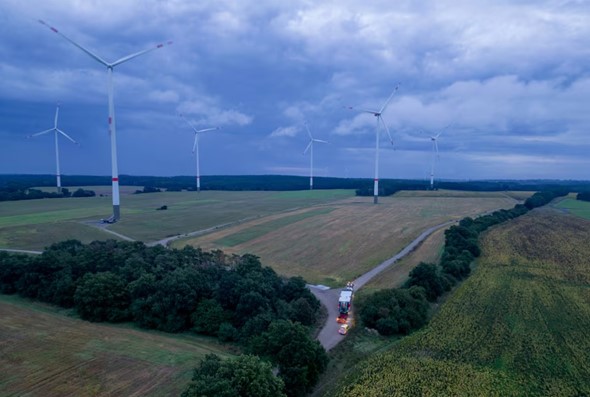
Germany's Wind Energy Growth Slows for 2024, Potentially Increasing Fossil Fuel Dependence
Wind energy production in Germany is projected to increase by only 1% in 2024, marking the slowest growth in three years. This deceleration is attributed to both low wind speeds and a slowdown in the expansion of new wind generation capacity, which could hinder the progress of Germany's leading source of electricity.
The sluggish growth in wind energy may compel utilities to ramp up fossil fuel-based power generation by late 2024, especially if industrial demand rises and household heating needs increase during winter. Such a shift could reverse the current trend of declining emissions in Germany's power sector, where pollution levels have reached their lowest in over a decade in 2024.
Wind Power Levels Off
In 2023, wind energy surpassed coal as Germany's primary electricity source, and it continues to lead in 2024. Wind power contributed approximately 28% of Germany's utility-scale electricity generation in the first seven months of 2024, according to data from the energy think tank Ember. This is an increase from 27% in 2023, outpacing coal's 19.5% and solar's 17.5% shares so far this year.
However, wind power generation hit its lowest level in over a year in July due to low wind speeds, a common summer occurrence. Although wind generation is expected to recover as wind speeds pick up from September onwards, forecasts suggest that overall wind production from September through the end of the year could fall below previous-year totals. This could lead to a 12% decrease in net generation during the final quarter compared to the same period in 2023.
Changing Projections
According to LSEG's latest forecasts, Germany's wind power is expected to generate 13,438 megawatt hours (MWh) in September, representing a 46% increase over September 2023. However, projections for the remainder of the year consistently fall short of the previous year's figures, averaging nearly a 12% decline in the final quarter.
If these forecasts hold, Germany's total wind generation for 2024 would be approximately 196,189 MWh, reflecting a mere 0.9% increase from 2023's total of 194,432 MWh. This modest growth contrasts sharply with the 12.4% increase seen in 2023 and the 11.2% rise in 2022, likely disappointing advocates of clean energy. It's important to note that these forecasts could change as wind speeds and weather conditions fluctuate.
Capacity Dynamics
In the first half of 2024, Germany approved nearly 900 new wind turbines with a combined generation capacity of 5,021 megawatts (MW), setting a record and demonstrating the government's continued commitment to clean energy growth. However, the number of operational turbines actually decreased, with 252 new turbines being connected to the grid while 282 were decommissioned. The new turbines, though more powerful, replace only 380 MW of the 1,310 MW brought online.
The generation potential of this newly configured fleet remains uncertain and depends on wind conditions across key farms. Currently, LSEG's forecasts indicate that while wind generation may slightly exceed long-term levels in the short term, it is expected to fall below average output rates later in the year due to slower-than-usual wind speeds.
Emissions Impact
If the wind generation forecasts are accurate, Germany's wind output might see only modest year-on-year growth in 2024, despite the introduction of newer and larger turbines. To compensate for potential power supply shortfalls, German power producers may need to increase coal and gas-fired generation. Although fossil fuel-fired power generation in Germany fell by 14.5% in the first seven months of 2024, reaching a record low, these emissions could rise significantly if wind output falters and fossil fuels are used to fill the gap.